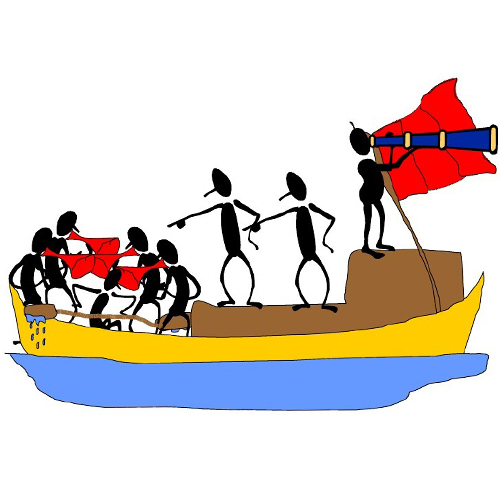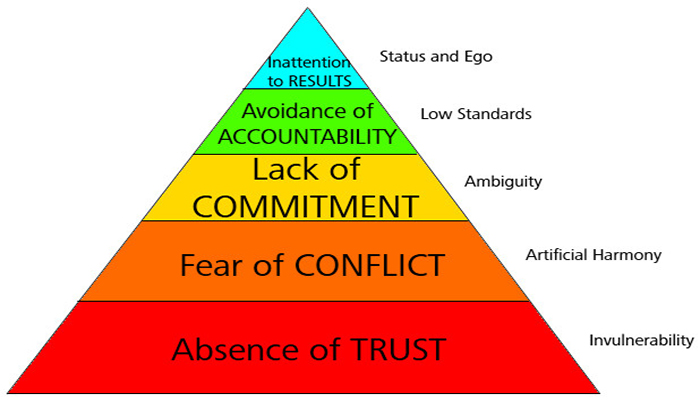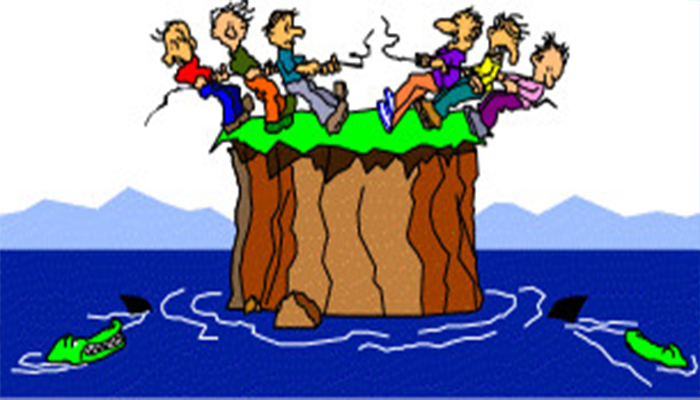Anatomy of dysfunctional teams

 Today if we dig into the anatomy of high-performing teams, the reasons for cohesiveness are clearly outlaid into their ‘Operational DNA’.
Today if we dig into the anatomy of high-performing teams, the reasons for cohesiveness are clearly outlaid into their ‘Operational DNA’.
 High-Performing Teams
High-Performing Teams
· Members are comfortable asking for help, admitting their mistakes, offer apologies and open to critical feedback & guidance.
· Each one is well aware of team member’s core strengths and shortcomings.
· They avoid doing post-mortems and work on repairing, getting things functional.
· With fewer and limited resources, they stretch to accomplish more.
 Managing their reputation well by putting on a mask, camouflaging weaknesses, and discouraging and back-stabbing others.
Managing their reputation well by putting on a mask, camouflaging weaknesses, and discouraging and back-stabbing others.
· hesitate to ask for help or guidance, due to ego and lack of openness.
· hesitate to go the extra mile to offer help outside their areas of responsibility.
· Hold grudges, and prejudices against others, jump to conclusions and frame wrong notions/intentions about others.
· They try to demote star employees, average employees piggyback ride on star performers and pull down the enthusiasm by de-motivating others.
· They openly discuss points of conflict or controversial opinions and try to arrive at a consensus spread around common objectives.
· They appreciate other's skills and talents, devoid of jealousies, myself, and ego hassles.
· Star employees are retained and average ones are coaxed to contribute better.
On the flip side, Dysfunctional teams are notorious for

Managing their reputation well by putting on a mask, camouflaging weaknesses, discouraging and back-stabbing others.
· Hesitate to ask for help or guidance, due to ego and lack of openness.
· Hesitate to go an extra mile to offer help outside their areas of responsibilities.
· Hold grudges, prejudices against others, jump to conclusions and frame wrong notions/intentions about others.
· They try to demote star employees, average employees’ piggy-back ride on star performers and pull down the enthusiasm by de-motivating others.

Common dysfunctional dynamics in a team are
#1 Absence of trust:

When team members trust each other, they no longer feel vulnerable to exposing their weaknesses or ask for help to improve. Mistakes made are not feared and a trusting environment accommodates shortcomings, develops ways & trains its members to overcome shortcomings, rather than creating an issue by punishing it. Leaders engage in open and constructive comments to develop and build members.
When there is a dearth of trust among team members, people are constantly trying to protect their reputations and cast blame on others when a mistake is made. It is just the team is sailing in a boat built on artificial harmony, where there are a lot of undercurrents, that can anytime turn the team topsy-turvy.

When trust is absent, teams show artificial harmony, due to which they desist from openly sharing conflicting views. So even if an idea holds strong merit, a member may be reluctant to share due to fear of being ridiculed. There is a clear line between conflicts personal vs conceptual. Constructive conflicts debate over ideas, processes, techniques etc, not a personal attack approach. It involves listening to the other’s point of view before framing conclusions and giving others a chance for others to unbolt their expressions and ideologies.
Bottling up resentment, not speaking up creates more dirty politics and formation of biases /prejudices. Meetings become a boring formality and where ‘ yes , yes ‘ is the only answer. It is healthy to disagree as long as the disagreements are forcing better solutions and taking every perspective into account while arriving at decisions.
#3 Lack of commitment:
In a team, it is important everyone is on the same page and goals are clearly communicated and committed to. Commitment creates clarity around priorities and aligns team around common objectives. When commitment is missing, there breeds ambiguity and lack of direction among members which leads to paralysis of analysis and work delays.
#4 Avoidance of accountability:
 Accountability creates a clear sense of responsibility, of what is expected, your duties, and the consequence if your fail to do so. Each team player is accountable for their part in performance and contributions to the team goals. When one avoids accountability, it encourages mediocrity which may not be aligned on key deliverables and can miss deadlines.
Accountability creates a clear sense of responsibility, of what is expected, your duties, and the consequence if your fail to do so. Each team player is accountable for their part in performance and contributions to the team goals. When one avoids accountability, it encourages mediocrity which may not be aligned on key deliverables and can miss deadlines.
When team accountability is high, even the average performers are pressed to improve and unhesitatingly take corrective action to achieve the quality of work within the stipulated time. Each team member is in a relay race, where the performance of each contributes to the group outcome. There is no ambiguity as expectations are set and if the failure occurs the entire team is at stake.
#5 Inattention to results:
 When accountability is missing people tend to cling to personal goals, at the expense of collective team goals. Team members need to forego their own interests for the good of the team. That’s why results have to be defined and adhered to so that no one would consider doing something purely to enhance one’s own status or ego. If collective goals are not achieved, we all lose. Failure is also a collective onus of the team, not individual members' debit.
When accountability is missing people tend to cling to personal goals, at the expense of collective team goals. Team members need to forego their own interests for the good of the team. That’s why results have to be defined and adhered to so that no one would consider doing something purely to enhance one’s own status or ego. If collective goals are not achieved, we all lose. Failure is also a collective onus of the team, not individual members' debit.
A flourishing team is worth not just for the business benefits, but for the improvements it will make to your own state of mind. By practicing daily responsibilities judiciously, and cooperation for common goals you will witness improvement much faster. With persistence and patience, let your team change for the better.










